The Robotic Assisted Endovascular Systems Market is estimated to be valued at USD 102.1 billion in 2025 and is projected to reach USD 223.9 billion by 2035, registering a compound annual growth rate (CAGR) of 8.2% over the forecast period.
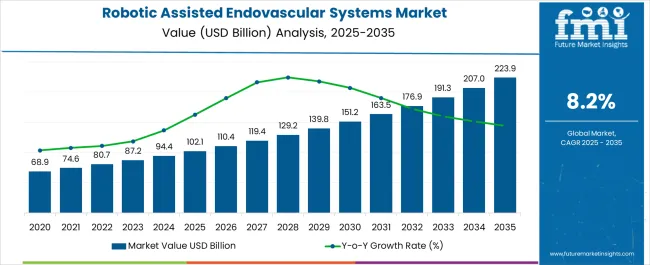
| Metric | Value |
|---|---|
| Robotic Assisted Endovascular Systems Market Estimated Value in (2025 E) | USD 102.1 billion |
| Robotic Assisted Endovascular Systems Market Forecast Value in (2035 F) | USD 223.9 billion |
| Forecast CAGR (2025 to 2035) | 8.2% |
The robotic assisted endovascular systems market is expanding steadily as demand rises for minimally invasive procedures that offer precision, reduced recovery times, and improved patient safety. Advances in robotic navigation, imaging integration, and microcatheter manipulation are enhancing surgical accuracy in complex vascular interventions. Growing prevalence of cardiovascular and neurovascular conditions, coupled with the aging global population, is reinforcing the need for advanced treatment options.
Hospitals and surgical centers are increasingly adopting robotic systems to improve clinical outcomes and streamline procedural workflows. Strategic investments by medical device companies in product innovation and training programs are also accelerating adoption.
Favorable reimbursement policies and regulatory approvals in developed regions further support growth, while emerging economies present opportunities for wider market penetration. The outlook remains optimistic as robotics become an essential component of modern endovascular surgery, enabling improved procedural efficiency and long-term patient outcomes.
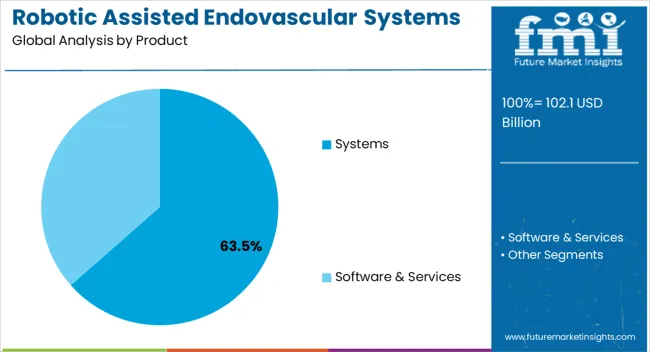
The systems segment is projected to hold 63.50% of total revenue by 2025, making it the leading product category. This dominance is driven by the growing preference for integrated robotic platforms that enhance precision, reduce surgeon fatigue, and improve patient outcomes in endovascular procedures.
The ability of these systems to support real-time imaging, micro-scale accuracy, and minimally invasive access has elevated their adoption in high complexity interventions.
Increasing institutional investments in robotic infrastructure and ongoing technological advancements are further reinforcing the leadership of this segment within the product category.
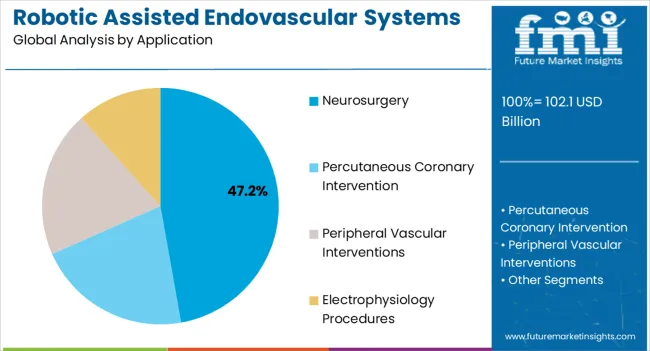
The neurosurgery segment is expected to contribute 47.20% of total market revenue by 2025 within the application category, positioning it as the dominant segment. Rising incidences of stroke, aneurysms, and other neurovascular disorders have intensified the need for advanced robotic assisted solutions.
Neurosurgical procedures demand extremely high precision, which robotic systems deliver through enhanced visualization and stable navigation. Growing clinical evidence supporting improved outcomes in complex brain and spine interventions has also encouraged adoption.
This combination of clinical necessity and technological capability is driving neurosurgery to the forefront of applications in this market.
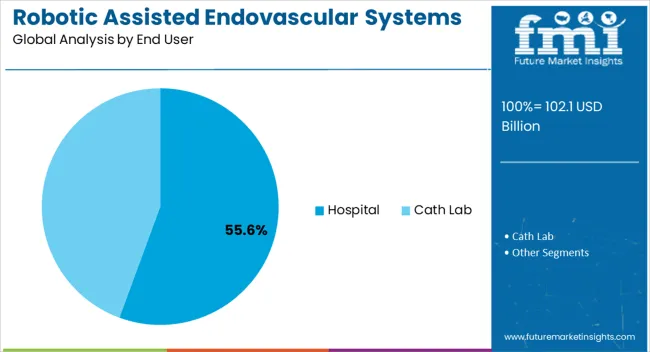
The hospital segment is anticipated to account for 55.60% of overall market revenue by 2025, making it the leading end user category. Hospitals remain the primary centers for advanced surgical procedures, where investment in robotic assisted systems is supported by large patient volumes and multidisciplinary surgical teams.
Adoption is further driven by the availability of specialized infrastructure, skilled professionals, and reimbursement coverage. Hospitals are also positioned to offer training and demonstration platforms for robotic assisted procedures, reinforcing their dominance in the market.
This strong foundation has secured hospitals as the leading end users in robotic assisted endovascular systems.
From 2020 to 2025, the global robotic assisted endovascular systems market experienced a CAGR of 6.5%, reaching a market size of USD 102.1.0 million in 2025.
From 2020 to 2025, robotic technology began to make its way into the field of endovascular interventions. The first generation of Robotic Assisted Endovascular Systems was introduced, offering improved precision and control during procedures. These early systems primarily focused on cardiovascular interventions, such as percutaneous coronary interventions (PCI) and transcatheter aortic valve replacement (TAVR).
As the technology advanced, more sophisticated robotic systems entered the market, incorporating features such as enhanced imaging capabilities, better ergonomics, and increased automation. The market expanded beyond cardiovascular procedures to include peripheral vascular interventions, such as treating peripheral artery disease (PAD) and performing endovascular aneurysm repair (EVAR).
Future Forecast for Robotic Assisted Endovascular Systems Industry:
Looking ahead, the global robotic assisted endovascular systems industry is expected to rise at a CAGR of 8.6% from 2025 to 2035. During the forecast period, the market size is expected to reach USD 223.9 million by 2035.
The robotic assisted endovascular systems industry is expected to continue its growth trajectory from 2025 to 2035, driven by increasing adoption of advanced robotic assisted endovascular systems that offers higher efficiency and precision during endovascular procedures. Also, the growing demand for innovative, minimally invasive surgical procedures which reduce patient trauma and recovery time will drive the market’s growth.
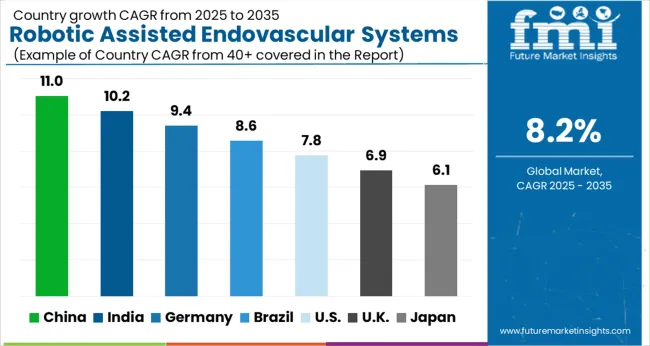
| Country | The United States |
|---|---|
| Market Size (USD million) by End of Forecast Period (2035) | USD 223.9 million |
| CAGR % 2025 to End of Forecast (2035) | 9.6% |
The robotic assisted endovascular systems industry in the United States is expected to reach a market size of USD 223.9 million by 2035, expanding at a CAGR of 9.6%.
The United States has a significant burden of cardiovascular and peripheral vascular diseases, including conditions such as coronary artery disease, peripheral artery disease, and aortic aneurysms. The rising prevalence of these diseases is driving the demand for advanced technologies like Robotic Assisted Endovascular Systems that can improve procedural outcomes and patient care.
| Country | The United Kingdom |
|---|---|
| Market Size (USD million) by End of Forecast Period (2035) | USD 12.0 million |
| CAGR % 2025 to End of Forecast (2035) | 7.9% |
The robotic assisted endovascular systems industry in the United Kingdom is expected to reach a market value of USD 12.0 million, expanding at a CAGR of 7.9% during the forecast period. Surgeons in the UK are increasingly recognizing the benefits of robotic assistance in endovascular procedures.
Robotic systems provide enhanced precision, stability, and control, resulting in improved procedural outcomes, reduced complications, and shorter recovery times for patients. Surgeon demand for these advantages is driving the adoption of Robotic Assisted Endovascular Systems.
| Country | China |
|---|---|
| Market Size (USD million) by End of Forecast Period (2035) | USD 4.9 million |
| CAGR % 2025 to End of Forecast (2035) | 6.8% |
The robotic assisted endovascular systems industry in China is anticipated to reach a market size of USD 4.9 million, moving at a CAGR of 6.8% during the forecast period. Increasing healthcare expenditure in China and expanding insurance coverage have made advanced medical technologies more accessible to patients.
This includes coverage for robotic-assisted procedures, incentivizing healthcare providers to invest in Robotic Assisted Endovascular Systems. The availability of insurance coverage for these procedures is contributing to the market growth in China.
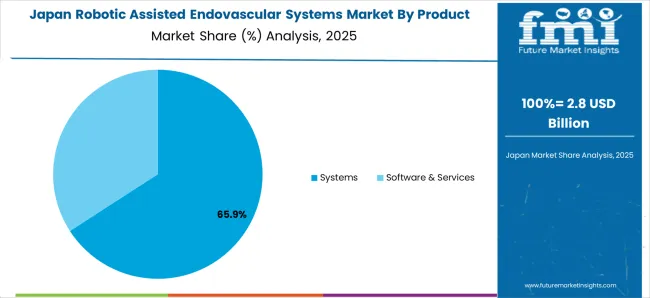
| Country | Japan |
|---|---|
| Market Size (USD million) by End of Forecast Period (2035) | USD 7.5 million |
| CAGR % 2025 to End of Forecast (2035) | 8.6% |
The robotic assisted endovascular systems industry in Japan is estimated to reach a market size of USD 7.5 million by 2035, thriving at a CAGR of 8.6%. Collaboration between international robotic system manufacturers and Japanese healthcare institutions is playing a significant role in driving the growth of the market. These collaborations focus on technology transfer, research and development, clinical trials, and training programs to promote the adoption and utilization of Robotic Assisted Endovascular Systems in Japan.
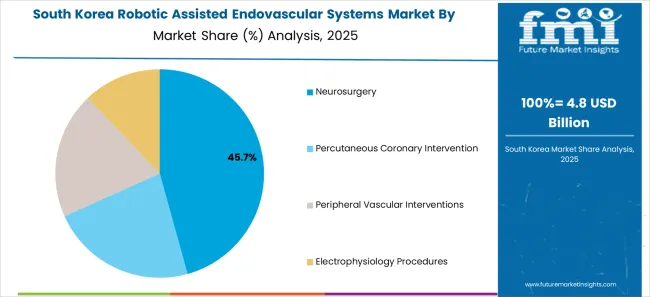
| Country | South Korea |
|---|---|
| Market Size (USD million) by End of Forecast Period (2035) | USD 2.1 million |
| CAGR % 2025 to End of Forecast (2035) | 4.8% |
The robotic assisted endovascular systems industry in South Korea is expected to reach a market size of USD 2.1 million, expanding at a CAGR of 4.8% during the forecast period. Patients in South Korea are becoming more aware of and demanding advanced treatment options.
They seek minimally invasive procedures that offer faster recovery, reduced pain, and improved quality of life compared to traditional open surgeries. Robotic Assisted Endovascular Systems enable minimally invasive interventions, making them appealing to patients and contributing to the growth of the market.
The systems is expected to dominate the robotic assisted endovascular systems industry with a CAGR of 8.8% from 2025 to 2035. They are transforming the way in which medical procedures are performed.
These systems are contributing to the growth of this market in many ways as they allow for increased accuracy, faster procedures, and less invasive surgeries.
Endovascular operations are streamlined using robotic equipment, which give surgeons exquisite control and dexterity. They can help with activities including catheter manipulation, guidewire setting, and suturing, which improves the effectiveness of the procedures and cuts down on the time needed to complete them.
The percutaneous coronary intervention application segments are expected to dominate the robotic assisted endovascular systems industry with a CAGR of 9.9% from 2025 to 2035. This segment captures a significant market share in 2025. By unblocking or widening restricted coronary arteries, percutaneous coronary intervention is a minimally invasive treatment used to treat coronary artery disease.
Because it is less invasive than conventional open-heart operations, it has grown in popularity. The need for cutting-edge technology like RAES to further enhance procedural results and patient experience has been fueled by the desire for minimally invasive therapies like percutaneous coronary intervention.
The hospital segment is expected to dominate the robotic assisted endovascular systems industry with a CAGR of 9.0% from 2025 to 2035. Hospitals are leading the way in embracing and putting innovative medical technologies into practice. Hospitals understand the value of integrating robotic-assisted endovascular systems into their facilities because these systems improve precision, accuracy, and patient outcomes. Their investment in RAES technology stimulates demand for these systems, which expands the market.
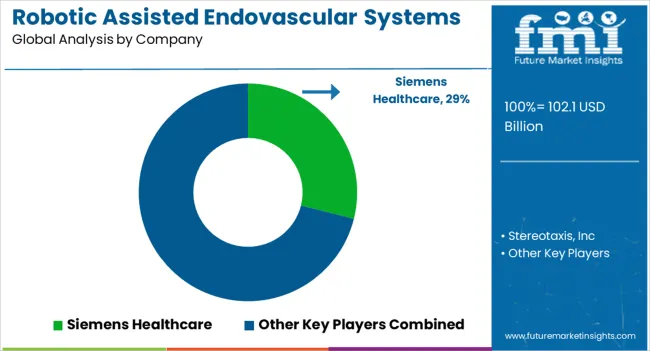
The robotic assisted endovascular systems withdrawal device sector is fiercely competitive, with many companies fighting for market dominance. To stay ahead of the competition in such a circumstance, essential players must employ smart techniques.
Key Strategies Used by the Participants
Product Development
To produce novel products that increase effectiveness, dependability, and affordability, businesses make substantial expenditures in research and development. Product innovation enables companies to stand out from the competition while also meeting the shifting needs of their customers.
Strategic Alliances & Collaborations
Strategic partnerships and alliances with other companies are frequently formed by significant players in an industry to take benefit from each other's advantages and expand their market reach. Through such partnerships, businesses may also obtain access to new technologies and markets.
Expansion into Emerging Markets
In emerging economies like China as well as India, the robotic assisted endovascular systems removal device business is rising significantly. To boost their presence in these regions, major companies are expanding their supply chains and building regional manufacturing sites.
Acquisitions and mergers
Leading companies in the robotic assisted endovascular systems withdrawal devices industry routinely use mergers and acquisitions to bolster their market positions, broaden their product offerings, and enter new markets.
Key Developments in the Robotic Assisted Endovascular Systems Market:
The global robotic assisted endovascular systems market is estimated to be valued at USD 102.1 billion in 2025.
The market size for the robotic assisted endovascular systems market is projected to reach USD 223.9 billion by 2035.
The robotic assisted endovascular systems market is expected to grow at a 8.2% CAGR between 2025 and 2035.
The key product types in robotic assisted endovascular systems market are systems and software & services.
In terms of application, neurosurgery segment to command 47.2% share in the robotic assisted endovascular systems market in 2025.






Our Research Products

The "Full Research Suite" delivers actionable market intel, deep dives on markets or technologies, so clients act faster, cut risk, and unlock growth.

The Leaderboard benchmarks and ranks top vendors, classifying them as Established Leaders, Leading Challengers, or Disruptors & Challengers.

Locates where complements amplify value and substitutes erode it, forecasting net impact by horizon

We deliver granular, decision-grade intel: market sizing, 5-year forecasts, pricing, adoption, usage, revenue, and operational KPIs—plus competitor tracking, regulation, and value chains—across 60 countries broadly.

Spot the shifts before they hit your P&L. We track inflection points, adoption curves, pricing moves, and ecosystem plays to show where demand is heading, why it is changing, and what to do next across high-growth markets and disruptive tech

Real-time reads of user behavior. We track shifting priorities, perceptions of today’s and next-gen services, and provider experience, then pace how fast tech moves from trial to adoption, blending buyer, consumer, and channel inputs with social signals (#WhySwitch, #UX).

Partner with our analyst team to build a custom report designed around your business priorities. From analysing market trends to assessing competitors or crafting bespoke datasets, we tailor insights to your needs.
Supplier Intelligence
Discovery & Profiling
Capacity & Footprint
Performance & Risk
Compliance & Governance
Commercial Readiness
Who Supplies Whom
Scorecards & Shortlists
Playbooks & Docs
Category Intelligence
Definition & Scope
Demand & Use Cases
Cost Drivers
Market Structure
Supply Chain Map
Trade & Policy
Operating Norms
Deliverables
Buyer Intelligence
Account Basics
Spend & Scope
Procurement Model
Vendor Requirements
Terms & Policies
Entry Strategy
Pain Points & Triggers
Outputs
Pricing Analysis
Benchmarks
Trends
Should-Cost
Indexation
Landed Cost
Commercial Terms
Deliverables
Brand Analysis
Positioning & Value Prop
Share & Presence
Customer Evidence
Go-to-Market
Digital & Reputation
Compliance & Trust
KPIs & Gaps
Outputs
Full Research Suite comprises of:
Market outlook & trends analysis
Interviews & case studies
Strategic recommendations
Vendor profiles & capabilities analysis
5-year forecasts
8 regions and 60+ country-level data splits
Market segment data splits
12 months of continuous data updates
DELIVERED AS:
PDF EXCEL ONLINE
Robotics-Assisted Telesurgery Market Size and Share Forecast Outlook 2025 to 2035
Robotic Angiography Systems Market
Robotic Catheterization Systems Market Growth – Innovations, Trends & Forecast 2025-2035
Laparoscopic Robotic-assisted Procedures Market Size and Share Forecast Outlook 2025 to 2035
Robotic Warfare Market Size and Share Forecast Outlook 2025 to 2035
Robotic Lawn Mower Market Size and Share Forecast Outlook 2025 to 2035
Robotics Welding Market Size and Share Forecast Outlook 2025 to 2035
Endovascular Aneurysm Repair (EVAR) Market Size and Share Forecast Outlook 2025 to 2035
Robotic Rehab Tools Market Analysis - Size, Share, and Forecast Outlook 2025 to 2035
Robotic Packaging Machines Market Size and Share Forecast Outlook 2025 to 2035
Robotic Lung Biopsy Market Size and Share Forecast Outlook 2025 to 2035
Robotics as a Service (RaaS) Market Size and Share Forecast Outlook 2025 to 2035
Endovascular Therapy Devices Market Size and Share Forecast Outlook 2025 to 2035
Robotic X-ray Scanner Market Size and Share Forecast Outlook 2025 to 2035
Robotic Aseptic Syringe Filler Capper Market Size and Share Forecast Outlook 2025 to 2035
Robotic Vision Market Size and Share Forecast Outlook 2025 to 2035
Robotics Actuators Market Size and Share Forecast Outlook 2025 to 2035
Assisted Walking Devices Market Size and Share Forecast Outlook 2025 to 2035
Systems Administration Management Tools Market Size and Share Forecast Outlook 2025 to 2035
Robotic Biopsy Devices Market Insights - Trends & Forecast 2025 to 2035

Thank you!
You will receive an email from our Business Development Manager. Please be sure to check your SPAM/JUNK folder too.
Chat With
MaRIA